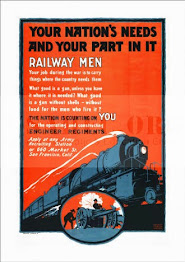Veteran's History Project, a Project of the Library of Congress
We celebrate Veteran's Day on November 11 each year – in commemoration of all veteran service, but especially for the 11th hour of the 11th day of the 11th month of 1918, when the armistice or peace was declared at the end of World War I.
And in recognition of this, in the year 2000, Congress passed Public Law 106-308, creating the Veteran's History Project (VHP), part of the American Folklife Center of the Library of Congress (LOC). The project
“collects, preserves, and makes accessible the personal accounts of American war veterans so that future generations may hear directly from veterans and better understand the realities of war.”
So this Veteran's Day, become involved with the VHP. Help by filming a first-hand account of a war memory. And if you are the beneficiary of a deceased veteran's diary, letters, photographs or home movies, think about donating items or transcriptions to the project.
Memorabilia from any of the following conflicts are accepted:
• World War I (1914-1920)
• Korean War (1950-1955)
• Vietnam War (1961-1975)
• Persian Gulf War (1990-1995)
• Afghanistan and Iraq conflicts (2001-present)
All interviews are conducted by volunteers, such as ourselves. And once submitted they are archived by LOC.To view the catalog of completed projects, follow the “SEARCH THE VETERANS COLLECTIONS” link. Many have been digitized and added to the website. Enter any number of criteria, from the veteran's name to the conflict or era.
The “HOW TO PARTICIPATE” section defines five easy steps:
1. Register online
2. Print the Project Field Kit
3. Prepare for the interview
4. Conduct the interview
5. Send the collection to the Library of Congress, keeping a copy for yourself
The Field Kit contains required forms and a printable brochure.
• Biographical Data Form
• Veterans Release Form
• Interviewer's Release Form
• Media and Formats Standards
• Audio and Video Recording Log
• Photograph Log
• Manuscript Data Sheet
The Frequently Asked Questions contain tips applicable to any oral history project. (Keep these tips in mind as you prepare to see family over the next coming months.) Some excerpts include:
• It is important to prepare for an interview.
• Prepare written questions ahead of time, and conduct a pre-interview, if possible.
• Use the highest-quality video or audio recorder available. Digital and Hi-8 video recordings are preferred. (Extended time speeds and microcassettes are not accepted).
• Be familiar with and test recording equipment before beginning.
• Mount cameras on tripods and position a few feet from the interviewee. Focus on the face, upper body and hands, and avoid the zoom feature.
• For audio interviews, use an external microphone positioned 9-inches from the interviewee.
• Use a microphone stand, and be sure the tape has started recording before you start speaking.
• Interview in a quiet, well-lit room and avoid fluorescent lights and extraneous noises, such as clocks, heating / cooling systems, phones, televisions and conversations.
• Be sure all questions and answers are recorded.
• At the beginning, state the date and place of the interview.
• State the name of the person being interviewed, his/her birth date and names of persons assisting.
• Identify the war, branch of service, rank and where the veteran served. For civilians, record what type of work was performed.
For example: Today is Friday, June 7, 2003 and we are interviewing John Smith at his home. Mr. Smith is 78 years old, having been born on November 23, 1923. My name is Jane Doe and I'll be the interviewer. John Smith is my uncle. He is my mother's brother. Uncle John, could you state for the recording what war and branch of service you served in? [pause for answer] What was your rank? [pause for answer] Where did you serve? [pause for answer]
• Keep questions short, and avoid complicated, multipart questions.
• Ask “how, when and why” questions, rather than ones answered by a simple “yes or no”.
• Don't begin with questions about painful or controversial topics.
• Be patient and give the veteran time to reflect before going to a new question.
• Consider asking to see photographs, commendations and personal letters as a way to enhance the interview. Such documents encourage memories and provoke interesting stories.
• Use follow-up questions to elicit more details. Examples include: When did that happen? Did that happen to you? What did you think about that? What are the steps in doing that?
• Keep the tape recorder or video camera running throughout the interview, unless you are asked to turn it off. And never record secretly.
Finally, remember this is the veteran's story, and not your own. Make it all about him or her, and avoid interjecting your own experiences.
For more information on Veteran's Day located at RootsWeb, please see Julie's Genealogy – Veteran's Day.
From Using RootsWeb By Mary Harrell-Sesniak
“Genealogy is not just a pastime; it's a passion.”
Genealogy Tip byBy Joan Young
Military Databases on RootsWeb and Beyond
For family history researchers, November 11th, whether it’s titled Veteran's Day, Remembrance Day, or Armistice Day, offers an incentive to learn and to share information about family members with military service.
MILITARY DATA ON THE INTERNET:
Worldwide: http://www.cyndislist.com/milres.htm
USA: http://www.cyndislist.com/military.htm
MILITARY DATABASES ON ROOTSWEB
Did you know that volunteers have submitted military data to RootsWeb's User-Contributed Databases? You can find a list of the military databases and the submitters here.
The military databases found in RootsWeb's User-Contributed Databases include complete or partial listings of battalion units, bombardiers, ship crews, Army nurses, draft and enlistment records, radar training groups, radio operators and much more. The list of records submitted by volunteers is extensive.
Often the databases are the result of personal research. Once the information is gathered, generous volunteers have decided to share what they have found. Many genealogists send away for records in the course of their research and create a database from the information they have received. Researchers may have undertaken a project to gather information about the crew who served on a specific ship in wartime, or the members of a battalion. Either way, the end result can provide a goldmine of information when submitted for free access and searching at RootsWeb.
You can search all of the military databases in RootsWeb's User-Contributed Databases here.
Or perhaps you have collected military information you would like to share. If you have more than a single document or record listing either partial or complete military data, consider submitting it to the RootsWeb User-Contributed Databases here.
As an alternative, if you have a single document for a family member, you may wish to post it on an appropriate RootsWeb message board selecting the Military classification when posting.
You may consider posting military data on a surname board, or use an appropriate board found among the Military Topic boards.
Sharing military data is a fitting tribute and remembrance for those who have so selflessly served their country.
Wednesday, November 10, 2010 | Labels: research | 0 Comments
Subscribe to:
Posts (Atom)






